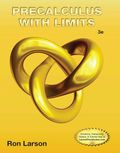
(a)
The maximum profit for various numbers of units ordered.
(a)
Answer to Problem 62E
It is a fair estimate that the maximum profit from the sales is 3375$
Explanation of Solution
Given information:
Consider the following table,

Where x is the number of units and P is the profit from them.
Formula used:
The maximum profit value is taken from the table P.
Calculation:
To estimate the maximum profit from the table compare the values of P among them. This gives,
Therefore it is a fair estimate that the maximum profit from the sales is 3375$
Conclusion:
The maximum profit from the sales is 3375$
(b)
The relation defined by the ordered pairs represents P as a function of X.
(b)
Answer to Problem 62E
As no single value in x-axis is related to more than one element in y-axishence, this relation is a function.
Explanation of Solution
Given information:
Consider the following table,

Where x is the number of units and P is the profit from them.
Formula used:
The x value is plotted along the horizontal axis and P value is plotted along the vertical axis.
Calculation:
A graphical plot is prepared taking x along the x-axis and P along the y-axis.

As no single value in x-axis is related to more than one element in y-axis. Hence, this relation is a function.
Conclusion:
The graph has the value that increases continuously and then decreases.
(c)
The domain of the function.
(c)
Answer to Problem 62E
As the number of units sold cannot be less than 0, the domain 0f the function is
Explanation of Solution
Given information:
Consider the following table,

Where x is the number of units and P is the profit from them.
Formula used:
Calculation:
Consider the following data;
Cost price up to 100 units is $60/unit,
Above 100, cost price per unit is reduced by $0.15 for each extra unit purchased,
Selling price is $90/unit.
Assume x be the number of units sold. So,
Simplifying it further,
Next
As the number of units sold cannot be less than 0, the domain 0f the function is
Conclusion:
The domain 0f the function is
Chapter 1 Solutions
EBK PRECALCULUS W/LIMITS
- a -> f(x) = f(x) = [x] show that whether f is continuous function or not(by using theorem) Muslim_mathsarrow_forwardUse Green's Theorem to evaluate F. dr, where F = (√+4y, 2x + √√) and C consists of the arc of the curve y = 4x - x² from (0,0) to (4,0) and the line segment from (4,0) to (0,0).arrow_forwardEvaluate F. dr where F(x, y, z) = (2yz cos(xyz), 2xzcos(xyz), 2xy cos(xyz)) and C is the line π 1 1 segment starting at the point (8, ' and ending at the point (3, 2 3'6arrow_forward
- I need help in ensuring that I explain it propleryy in the simplifest way as possiblearrow_forwardI need help making sure that I explain this part accutartly.arrow_forwardPlease help me with this question as I want to know how can I perform the partial fraction decompostion on this alebgric equation to find the time-domain of y(t)arrow_forward
- Please help me with this question as I want to know how can I perform the partial fraction on this alebgric equation to find the time-domain of y(t)arrow_forwardEvaluate F³ - dr where ♬ = (4z, -4y, x), and C' is given by (t) = (sin(t), t, cos(t)), 0≤t≤ñ .arrow_forwardMid-Term Review Find the formula for (f + g)(x). f(x) = x² - 10x + 25 and g(x) = x² - 10x + 24 (f + g) (x) = [ 2 ]x² X + DELL Skip Sarrow_forward
 Calculus: Early TranscendentalsCalculusISBN:9781285741550Author:James StewartPublisher:Cengage Learning
Calculus: Early TranscendentalsCalculusISBN:9781285741550Author:James StewartPublisher:Cengage Learning Thomas' Calculus (14th Edition)CalculusISBN:9780134438986Author:Joel R. Hass, Christopher E. Heil, Maurice D. WeirPublisher:PEARSON
Thomas' Calculus (14th Edition)CalculusISBN:9780134438986Author:Joel R. Hass, Christopher E. Heil, Maurice D. WeirPublisher:PEARSON Calculus: Early Transcendentals (3rd Edition)CalculusISBN:9780134763644Author:William L. Briggs, Lyle Cochran, Bernard Gillett, Eric SchulzPublisher:PEARSON
Calculus: Early Transcendentals (3rd Edition)CalculusISBN:9780134763644Author:William L. Briggs, Lyle Cochran, Bernard Gillett, Eric SchulzPublisher:PEARSON Calculus: Early TranscendentalsCalculusISBN:9781319050740Author:Jon Rogawski, Colin Adams, Robert FranzosaPublisher:W. H. Freeman
Calculus: Early TranscendentalsCalculusISBN:9781319050740Author:Jon Rogawski, Colin Adams, Robert FranzosaPublisher:W. H. Freeman
 Calculus: Early Transcendental FunctionsCalculusISBN:9781337552516Author:Ron Larson, Bruce H. EdwardsPublisher:Cengage Learning
Calculus: Early Transcendental FunctionsCalculusISBN:9781337552516Author:Ron Larson, Bruce H. EdwardsPublisher:Cengage Learning





